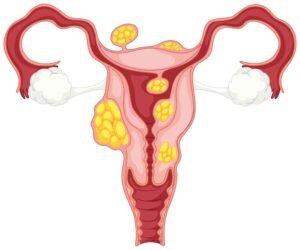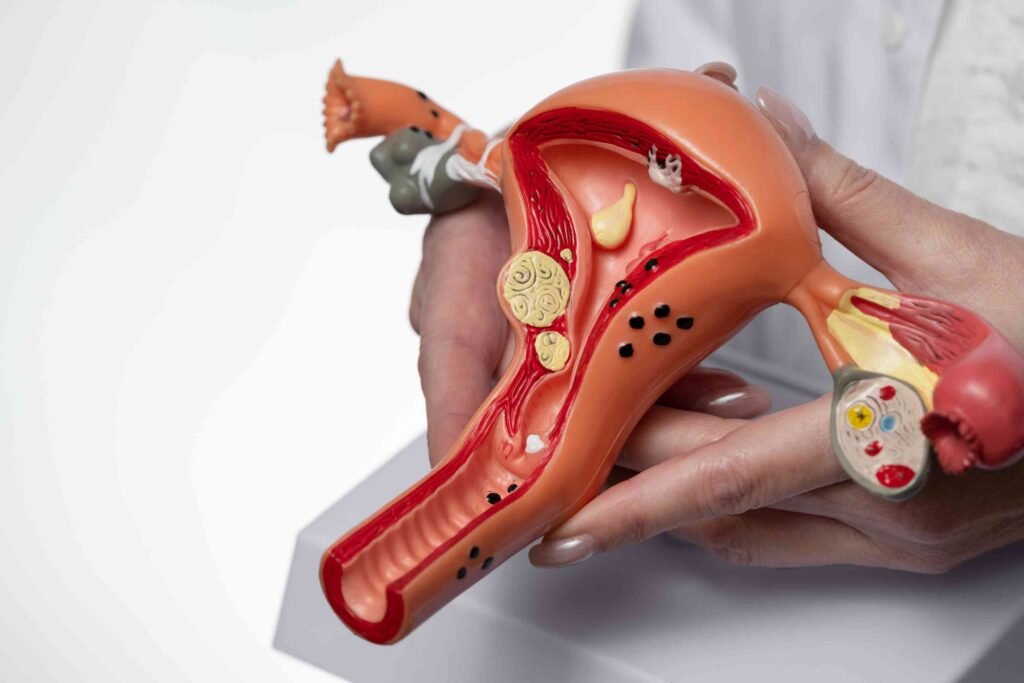Fibroids vs. Polyps: Understanding the Key Differences
When you’re dealing with unexpected symptoms like heavy bleeding, pelvic pain, or irregular periods, it’s only natural to go down the Google rabbit hole. Chances are, somewhere along the way, you’ve come across the terms fibroids and polyps—maybe even both at once. And while they might seem similar at a glance, there are actually some pretty key differences between them. But unless you’re fluent in medical speak, trying to understand those differences can get confusing fast.
That’s where this guide comes in. We’re going to break down everything you need to know about fibroids vs. polyps—what they are, how they’re different, the symptoms they cause, and how they’re treated. By the end, you’ll have a solid grasp of each condition, and hopefully a better sense of what might be going on in your own body.
What Exactly Are Fibroids and Polyps?
Fibroids:
Fibroids are benign (non-cancerous) tumors made up of muscle and connective tissue. They grow in the uterus, often during a woman’s reproductive years. Most of the time, fibroids start popping up when estrogen levels are high—think pregnancy, or before menopause—and they can vary in size from barely detectable to so large they cause visible bloating.

The thing about fibroids is they grow from the uterine muscle layer, and they can show up in different spots: inside the wall, pushing into the uterine cavity, hanging off the outside of the uterus, or even on a little stalk-like structure. It’s kind of wild how many ways they can show up.
And not everyone who has fibroids experiences symptoms. Some women don’t even know they have them until a routine ultrasound picks them up. But for others, they can cause serious discomfort, which we’ll get into shortly.
Polyps:
Polyps are also non-cancerous growths, but instead of growing from muscle tissue, they arise from the endometrial lining of the uterus—that’s the layer that sheds during your period. They’re usually smaller than fibroids and are often described as soft, finger-like projections. You might only have one polyp, or you could have several.
Polyps are more common as women approach menopause, though they can appear at any age. Unlike fibroids, which can grow to impressively large sizes, polyps tend to stay relatively small. But despite their size, they can still be a major source of annoyance and irregular bleeding.
Symptoms: Do Fibroids and Polyps Feel the Same?
This is one of the areas where things get a little tricky. Fibroids vs. polyps often come with overlapping symptoms, which can make diagnosis less straightforward than you’d hope. Still, there are subtle differences in how they show up.
Fibroid Symptoms
If you have fibroids, you might experience:
- Heavy or prolonged menstrual bleeding
- Pelvic pressure or pain
- Frequent urination (especially if a fibroid is pressing on your bladder)
- Lower back pain
- Pain during sex
- A feeling of fullness or bloating in the abdomen
- Difficulty getting pregnant (depending on size and location)

The bleeding associated with fibroids is often heavy and can lead to anemia over time. Some women even end up needing iron supplements—or in more severe cases, blood transfusions.
Polyp Symptoms
Polyps also mess with your cycle, but they tend to cause slightly different issues:
- Irregular menstrual cycles
- Spotting between periods
- Bleeding after sex
- Bleeding after menopause
- Infertility (less common, but still possible)
Polyps are more likely to cause breakthrough bleeding or spotting rather than the heavy, flooding-type periods you might get with fibroids. Still, both conditions can be disruptive and frustrating.
Causes and Risk Factors: Why Do These Things Even Happen?
When it comes to understanding fibroids vs. polyps, it’s helpful to look at what causes them—or at least what increases the chances you’ll develop them.
What Causes Fibroids?
The exact cause of fibroids isn’t fully understood, but hormones play a major role. Estrogen and progesterone—your two main female sex hormones—encourage fibroid growth. That’s why fibroids often grow during pregnancy and shrink after menopause, when hormone levels drop.
Other risk factors include:
- Family history of fibroids
- African-American heritage (Black women are more likely to develop fibroids and at younger ages)
- Obesity
- Early onset of menstruation
What Causes Polyps?
Polyps are also linked to hormone levels, particularly estrogen, but there are a few other factors in play too:
- Being over 40 (though they can happen at any age)
- Obesity
- High blood pressure
- Hormone replacement therapy
- Tamoxifen use (a medication used in breast cancer treatment)
In both cases, it’s not like you can completely prevent fibroids or polyps from developing, but being aware of your risk factors is a good first step in monitoring symptoms and catching issues early.
How Are They Diagnosed?
If you’re experiencing symptoms that could point to either of these conditions, your doctor might order a few tests. This part isn’t super fun, but it’s crucial to get a clear picture of what’s going on.
Here’s what might be involved:
- Pelvic exam – Your doctor might feel for unusual growths or changes in the shape of your uterus.
- Ultrasound – This is often the first-line tool. It helps identify the presence and location of fibroids or polyps.
- Hysteroscopy – A small camera is inserted through the cervix into the uterus so your doctor can actually see what’s going on.
- Saline infusion sonogram (SIS) – This is a special type of ultrasound where saline is injected into the uterus to give clearer images of the inside lining.
- MRI – In some cases, especially with larger fibroids, an MRI might be used for a detailed view.

The process can feel a bit invasive, but accurate diagnosis is key. After all, the treatment approach for fibroids vs. polyps can be pretty different.
Treatment Options: What Can You Do About Them?
Okay, so now let’s get to the part everyone really wants to know—what happens if you’re diagnosed with fibroids or polyps?
The good news: both conditions are treatable. The approach just depends on your symptoms, age, fertility goals, and how severe things are.
Treating Fibroids
For mild cases, treatment might not even be necessary. But if fibroids are interfering with your life, here are some of the options:
- Medications – Hormonal birth control can help reduce bleeding. GnRH agonists (like Lupron) can shrink fibroids temporarily.
- Uterine fibroid embolization (UFE) – A minimally invasive procedure that cuts off the blood supply to the fibroids, causing them to shrink.
- Myomectomy – Surgical removal of fibroids while leaving the uterus intact. Good option if you want to preserve fertility.
- Hysterectomy – Removal of the uterus entirely. This is considered a permanent solution and ends menstruation completely.
Treating Polyps
Polyps are usually easier to remove and treat:
- Polypectomy – This is a quick, often outpatient procedure where polyps are removed via hysteroscopy.
- Hormonal treatments – Birth control or progestins may be used to manage symptoms if surgery isn’t immediately needed.
- Watchful waiting – If a polyp isn’t causing symptoms, your doctor might just keep an eye on it.
In general, polyps are less likely to grow back after removal compared to fibroids, which unfortunately have a tendency to return in some cases.
Fertility and Pregnancy: Can They Affect Your Chances?
Yes, both fibroids and polyps can have an impact on fertility—but not always.
Fibroids, especially those located inside the uterine cavity, can make it harder for a fertilized egg to implant. They can also increase the risk of miscarriage or pregnancy complications like preterm labor.
Polyps can also interfere with implantation, especially if they distort the endometrial lining. In some cases, removing a polyp improves fertility outcomes significantly—especially for women undergoing IVF.
If you’re trying to conceive and you’ve been diagnosed with either of these, it’s worth having a detailed conversation with your OB-GYN or a fertility specialist. The approach may be very different depending on whether you’re dealing with fibroids vs. polyps.

Cancer Risk: Should You Be Worried?
This is a common fear, and it’s understandable. The word “tumor” tends to raise red flags.
The truth is, both fibroids and polyps are usually benign. It’s extremely rare for fibroids to become cancerous. In fact, the odds are less than 1%. Polyps have a slightly higher—but still low—risk of being precancerous or cancerous, especially in postmenopausal women. That’s one reason your doctor may recommend removing polyps if they show up after menopause.
So while cancer isn’t something to lose sleep over in most cases, regular monitoring and follow-up with your doctor is smart.
Final Thoughts:
While fibroids and polyps can both be a pain—literally and figuratively—they’re also manageable, treatable conditions. The main difference comes down to what they’re made of and where they grow. Fibroids are muscular growths in the wall of the uterus. Polyps are soft, tissue-based growths on the inner lining.
Both can cause bleeding and other symptoms, and both might impact your ability to conceive—but the treatment options and long-term outlooks are a bit different.



